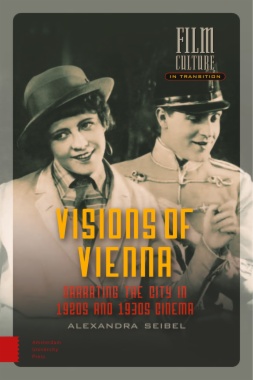Vienna, with its stunning architecture and unforgettable streetscape, has long provided a backdrop for filmmakers. Visions of Vienna offers a close look at how directors such as Erich von Stroheim, Ernst Lubitsch, and Max Ophüls made use of the city, and how the nostalgic glorification of the Habsburg era can be seen as directly tied to crucial issues of modernity. Films set in Vienna, Alexandra Seibel shows, persistently articulate the experience of displacement due to emigration, changing gender relations and anti-feminism, class distinction, and anti-Semitism, themes that run counter to the ongoing mystification of Vienna as the incarnation of "waltz dreams" and schmaltz.
- Cover
- Contents
- 1. Introduction
- Viennese Modernity and the Impact on Cinema
- The Structure of the Cinematic City
- 2. Fairgrounds and Vineyards
- Urban Topographies in the Viennese Films of Erich von Stroheim
- Introduction
- Reflections at the Fairground: Erich von Stroheim’s and Rupert Julian’s Merry-Go-Round (1923)
- Melodrama, Mass Culture, and Social Masquerade
- Deception and Reflection: The Entertainment Machinery
- Sex, Romance, and Spectacle: Leaving the Prater Behind
- Excess and Analysis: Erich von Stroheim’s The Wedding March (1928)
- Concentric City: Center, Circle, and Suburbs
- Baroque Modernity: The Aesthetics of the Rotten
- Repressed and Restricted Looks: A Geography of the Gaze
- Meet Me at the ‘Heuriger’: Tales of the Iron Man
- 3. Critical, Controversial, Conventional
- Viennese Girls in Films by Ophüls, Feyder, Hochbaum, and Forst
- Introduction
- Arthur Schnitzler’s Sweet Young Thing: Male Fantasy and Female Misery
- The Viennese Girl vs. the Femme Fatale
- The Viennese Girl in International Cinema
- Max Ophüls, Vienna, and Liebelei (1933)
- Variations of Reality in Liebelei: The Military and the Theater
- The Gaze of Oppressive Masculinity and the Need for Disguise
- The Kaiser and The Viennese Girl: Doing Away with the Habsburg Myth in Liebelei and De Mayerling à Sarajevo (1938)
- Happy Endings in Hollywood: Sidney Franklin’s Reunion in Vienna (1933) and Jacques Feyder’s Daybreak (1931)
- The Viennese Girl and the Truth of Music in Liebelei
- The Viennese Girl on Stage: Werner Hochbaum’s Vorstadtvarieté (1935)
- Willi Forst’s Maskerade (1934): The Viennese Girl and Social Folklore
- Living Backstage, Dying in the Backyard: The Drama of Marginalization in Liebelei
- 4. Women and the Market of Modernity
- G.W. Pabst’s The Joyless Street (1925)
- Introduction
- Leaving the Habsburg Myth Behind: Postwar Misery, Hugo Bettauer, and the Literature of Inflation
- A Taste for the Real: New Objectivity, Cynicism, and the Cult of Distance in Weimar Modernity
- The Weimar Street Film, the Street, and The Joyless Street9
- The Semi-Public Hotel: In the Realm of Purchasing Power
- The Public Street: Taking a Walk in Melchiorgasse
- Upstairs, Downstairs: Social Climbing Along a Vertical Axis
- Mother and Whore: The Convolution of the Inside and the Outside World
- Challenging the Male Gaze: The Female Subject in Armor
- The Transfer of Agency: Reclaiming the Joyless Streets
- Pabst’s Film Adaptation of Bettauer’s Book: Omitting the (Anti-)Semitic Discourse in The Joyless Street
- Death in the Mirror: The Killing of a Jewish Femme Fatale
- 5. The Sound of Make-Believe
- Ernst Lubitsch and the World of the Operetta
- Introduction
- ‘Retrospective Utopia’: The Myth of Vienna and the Operetta
- The Meaning of the Waltz: The High, the Low, and the Great Fall
- Contested Territory: The Operetta and Its Allure for Cinema
- Becoming Viennese: Music and Sexual Agency
- Ernst Lubitsch and the Naughty Operetta Tradition
- ‘What a Speller!’: Noise and Speech versus Song and Dance
- Making Love on a Park Bench: Private Boredom and Public Bliss
- The Taste of Mandelbaum and Greenstein: The Masquerade of Otherness
- Jewish Sophistication and the Viennese Operetta
- Coda
- 6. Conclusion
- Acknowledgements
- Notes
- Illustration Credits
- Filmography
- Bibliography
- Index of Film Titles
- Index of Names and Subjects

